|
THE EPIC OF
CREATION
ON MOST OF THE ANCIENT cylinder seals that have been found, symbols
that stand for certain celestial bodies, members of our solar
system, appear above the figures of gods or humans.
An Akkadian seal from the third millennium B.C., now at the
Vorderasiatische Abteilung of the State Museum in East Berlin
(catalogued VA/243), departs from the usual manner of depicting the
celestial bodies. It does not show them individually but rather as a
group of eleven globes encircling a large, rayed star.
It is clearly
a depiction of the solar system as it was known to the Sumerians: a
system consisting of twelve celestial bodies.
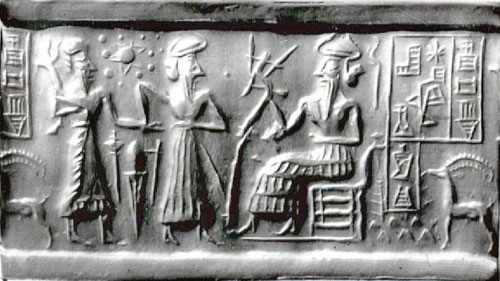
We usually show our solar system schematically as a line of planets
stretching away from the Sun in ever-increasing distances. But if we
depicted the planets, not in a line, but one after the other in a
circle (the closest, Mercury, first, then Venus, then Earth, and so
on).
If we now take a second look at an enlargement of the solar system
depicted on cylinder seal VA/243, we shall see that the "dots"
encircling the star are actually globes whose sizes and order
conform to that of the solar system.
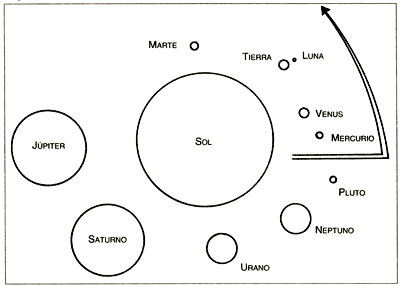
The small Mercury is followed
by a larger Venus. Earth, the same size as Venus, is accompanied by
the small Moon.
Continuing in a counter-clock-wise direction, Mars is
shown correctly as smaller than Earth but larger than the Moon or
Mercury.
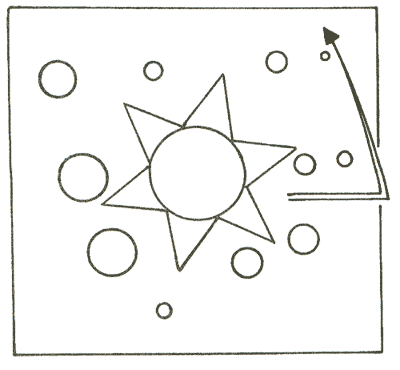
The ancient depiction then shows a planet unknown to us -
considerably larger than Earth, yet smaller than Jupiter and Saturn,
which clearly follow it.
Farther on, another pair perfectly matches
our Uranus and Neptune. Finally, the smallish Pluto is also there,
but not where we now place it (after Neptune); instead, it appears
between Saturn and Uranus.
Treating the Moon as a proper celestial body, the Sumerian depiction
fully accounts for all of our known planets, places them in the
correct order (with the exception of Pluto), and shows them by size.
The 4,500-year-old depiction, however, also insists that there was -
or has been - another major planet between Mars and Jupiter. It is,
as we shall show, the Twelfth Planet, the planet of the Nefilim.
If this Sumerian celestial map had been discovered and studied two
centuries ago, astronomers would have deemed the Sumerians totally
uninformed, foolishly imagining more planets beyond Saturn. Now,
however, we know that Uranus and Neptune and Pluto are really there.
Did the Sumerians imagine the other discrepancies, or were they
properly informed by the Nefilim that the Moon was a member of the
solar system in its own right, Pluto was located near Saturn, and
there was a Twelfth Planet between Mars and Jupiter?
The long-held theory that the Moon was nothing more than "a frozen
golf ball" was not discarded until the successful conclusion of
several U.S. Apollo Moon missions.
The best guesses were that the
Moon was a chunk of matter that had separated from Earth when Earth
was still molten and plastic. Were it not for the impact of millions
of meteorites, which left craters on the face of the Moon, it would
have been a faceless, lifeless, history-less piece of matter that
solidified and forever follows Earth.
Observations made by unmanned satellites, however, began to bring
such long-held beliefs into question. It was determined that the
chemical and mineral makeup of the Moon was sufficiently different
from that of Earth to challenge the "breakaway" theory. The
experiments conducted on the Moon by the American astronauts and the
study and analysis of the soil and rock samples they brought back
have established beyond doubt that the Moon, though presently
barren, was once a "living planet."
Like Earth it is layered, which
means that it solidified from its own original molten stage. Like
Earth it generated heat, but whereas Earth's heat comes from its
radioactive materials, "cooked" inside Earth under tremendous
pressure, the Moon's heat comes, apparently, from layers of
radioactive materials lying very near the surface.
These materials,
however, are too heavy to have floated up. What, then, deposited
them near the Moon's surface?
The Moon's gravity field appears to be erratic, as though huge
chunks of heavy matter (such as iron) had not evenly sunk to its
core but were scattered about. By what process or force, we might
ask? There is evidence that the ancient rocks of the Moon were
magnetized. There is also evidence I hat the magnetic fields were
changed or reversed. Was it by some unknown internal process, or by
an undetermined outside influence?
The Apollo 16 astronauts found on the Moon rocks (called breccias)
that result from the shattering of solid rock and its rewelding
together by extreme and sudden heat. When and how were these rocks
shattered, then re-fused? Other surface materials on the Moon are
rich in rare radioactive potassium and phosphorus, materials that on
Earth are deep down inside.
Putting such findings together, scientists are now certain that the
Moon and Earth, formed of roughly the same elements at about the
same time, evolved as separate celestial bodies. In the opinion of
the scientists of the U.S. National Aeronautics and Space
Administration (NASA), the Moon evolved "normally" for its first 500
million years. Then, they said (as reported in The New York Times),
The most cataclysmic period came 4 billion years ago, when celestial
bodies the size of large cities and small countries came crashing
into the Moon and formed its huge basins and towering mountains.
The huge amounts of radioactive materials left by the collisions
began heating the rock beneath the surface, melting massive amounts
of it and forcing seas of lava through cracks in the surface.
Apollo 15 found a rockslide in the crater Tsiolovsky six times
greater than any rockslide on Earth. Apollo16 discovered that the
collision that created the Sea of Nectar deposited debris as much as
1,000 miles away. Apollo 17 landed near a scarp eight times higher
than any on Earth, meaning it was formed by a moon-quake eight times
more violent than any earthquake in history.
The convulsions following that cosmic event continued for some 800
million years, so that the Moon's makeup and surface finally took on
their frozen shape some 3.2 billion years ago.
The Sumerians, then, were right to depict the Moon as a celestial
body in its own right. And, as we shall soon see, they also left us
a text that explains and describes the cosmic catastrophe to which
the NASA experts refer.
The planet Pluto has been called "the enigma." While the orbits
around the Sun of the other planets deviate only somewhat from a
perfect circle, the deviation ("eccentricity") of Pluto is such that
it has the most extended and elliptical orbit around the Sun. While
the other planets orbit the Sun more or less within the same plane,
Pluto is out of kilter by a whopping seventeen degrees. Because of
these two unusual features of its orbit, Pluto is the only planet
that cuts across the orbit of another planet, Neptune.
In size, Pluto is indeed in the "satellite" class: Its diameter,
3,600 miles, is not much greater than that of Triton, a satellite of
Neptune, or Titan, one of the ten satellites of Saturn. Because of
its unusual characteristics, it has been suggested that this
"misfit" might have started its celestial life as a satellite that
somehow escaped its master and went into orbit around the Sun on its
own.
This, as we shall soon see, is indeed what happened - according to
the Sumerian texts.
And now we reach the climax of our search for answers to primeval
celestial events: the existence of the Twelfth Planet. Astonishing
as it may sound, our astronomers have been looking for evidence that
indeed such a planet once existed between Mars and Jupiter.
Toward the end of the eighteenth century, even before Neptune had
been discovered, several astronomers demonstrated that "the planets
were placed at certain distances from the Sun according to some
definite law." The suggestion, which came to be known as Bode's Law,
convinced astronomers that a planet ought to revolve in a place
where hitherto no planet had been known to exist - that is, between
the orbits of Mars and Jupiter.
Spurred by these mathematical calculations, astronomers began to
scan the skies in the indicated zone for the "missing planet." On
the first day of the nineteenth century, the Italian astronomer
Giuseppe Piazzi discovered at the exact indicated distance a very
small planet (485 miles across), which he named Ceres.
By 1804 the
number of asteroids ("small planets") found there rose to four; to
date, nearly 3,000 asteroid0 have been counted orbiting the Sun in
what is now called the asteroid belt. Beyond any doubt, this is the
debris of a planet that had shattered to pieces. Russian astronomers
have named it Phayton ("chariot").
While astronomers are certain that such a planet existed, they are
unable to explain its disappearance. Did the planet self-explode?
But then its pieces would have flown off in all directions and not
stayed in a single belt. If a collision shattered the missing
planet, where is the celestial body responsible for the collision?
Did it also shatter?
But the debris circling the Sun, when added up,
is insufficient to account for even one whole planet, to say nothing
of two. Also, if the asteroids comprise the debris of two planets,
they should have retained the axial revolution of two planets. But
all the asteroids have a single axial rotation, indicating they come
from a single celestial body. How then was the missing planet
shattered, and what shattered it?
The answers to these puzzles have been handed down to us from
antiquity.
About a century ago the decipherment of the texts found in
Mesopotamia unexpectedly grew into a realization that there - in
Mesopotamia - texts existed that not only paralleled but also
preceded portions of the Holy Scriptures. Die Kielschriften und das
alte Testament by Eberhard Schrader in 1872 started an avalanche of
books, articles, lectures, and debates that lasted half a century.
Was there a link, at some early time, between Babylon and the Bible?
The headlines provocatively affirmed, or denounced: BABEL UND BIBEL.
Among the texts uncovered by Henry Layard in the ruins of the
library of Ashurbanipal in Nineveh, there was one that told a tale
of Creation not unlike the one in the Book of Genesis. The broken
tablets, first pieced together and published by George Smith in 1876
(The Chaldean Genesis), conclusively established that there indeed
existed an Akkadian text, written in the Old Babylonian dialect,
that related how a certain deity created Heaven and Earth and all
upon Earth, including Man.
A vast literature now exists that compares the Mesopotamian text
with the biblical narrative. The Babylonian deity's work was done,
if not in six "days," then over the span of six tablets. Parallel to
the biblical God's seventh day of rest and enjoyment of his
handiwork, the Mesopotamiaii epic devotes a seventh tablet to the
exaltation of the Babylonian deity and his achievements.
Appropriately, L. W. King named his authoritative text on the
subject The Seven Tablets of Creation.
Now called "The Creation Epic," the text was known in antiquity by
its opening words, Enuma Elish ("When in the heights").
The biblical
tale of Creation begins with the creation of Heaven and Earth; the
Mesopotamian tale is a true cosmogony, dealing with prior events and
taking us to the beginning of time:
Enuma elish la nabu shamamu
When in the heights Heaven had not been named
Shaplitu ammatitm shuma la zakrat
And below, firm ground [Earth] had not been called
It was then, the epic tells us, that two primeval celestial bodies
gave birth to a series of celestial "gods."
As the number of
celestial beings increased, they made great noise and commotion,
disturbing the Primeval Father. His faithful messenger urged him to
take strong measures to discipline the young gods, but they ganged
up on him and robbed him of his creative powers.
The Primeval Mother
sought to take revenge. The god who led the revolt against the
Primeval Father had a new suggestion: Let his young son be invited
to join the Assembly of the Gods and be given supremacy so that he
might go to fight singlehanded the "monster" their mother turned out
to be.
Granted supremacy, the young god - Marduk, according to the
Babylonian version - proceeded to face the monster, and, after a
fierce battle, vanquished her and split her in two. Of one part of
her he made Heaven, and of the other, Earth.
He then proclaimed a fixed order in the heavens, assigning to each
celestial god a permanent position. On Earth he produced the
mountains and seas and rivers, established the seasons and
vegetation, and created Man. In duplication of the Heavenly Abode,
Babylon and its towering temple were built on Earth. Gods and
mortals were given assignments, commandments, and rituals to be
followed.
The gods then proclaimed Marduk the supreme deity, and
bestowed on him the "fifty names" - the prerogatives and numerical
rank of the Enlilship.
As more tablets and fragments were found and translated, it became
evident that the text was not a simple literary work: It was the
most hallowed historical-religious epic of Babylon, read as part of
the New Year rituals. Intended to propagate the supremacy of Marduk,
the Babylonian version made him the hero of the tale of Creation.
This, however, was not always so.
There is enough evidence to show
that the Babylonian version of the epic was a masterful
religious-political forgery of earlier Sumerian versions, in which Anu, Enlil, and Ninurta were the heroes.
No matter, however, what the actors in this celestial and divine
drama were called, the tale is certainly as ancient as Sumerian
civilization. Most scholars see it as a philosophic work - the
earliest version of the eternal struggle between good and evil - or
as an allegorical tale of nature's winter and summer, sunrise and
sunset, death and resurrection.
But why not take the epic at face value, as nothing more nor less
than the statement of cosmologic facts as known to the Sumerians, as
told them by the Nefilim? Using such a bold and novel approach, we
find that the "Epic of Creation" perfectly explains the events that
probably took place in our solar system.
The stage on which the celestial drama of Enuma Elish unfolds is the
primeval universe. The celestial actors are the ones who create as
well as the ones being created. Act I:
When in the heights Heaven had not been named,
And below, Earth had not been called;
Naught, but primordial APSU, their Begetter,
MUMMU, and TIAMAT - she who bore them all;
Their waters were mingled together.
No reed had yet formed, no marshland had appeared.
None of the gods had yet been brought into being,
None bore a name, their destinies were undetermined;
Then it was that gods were formed in their midst.
With a few strokes of the reed stylus upon the first clay tablet -
in nine short lines - the ancient poet-chronicler manages to seat us
in front row center, and boldly and dramatically raise the curtain
on the most majestic show ever: the Creation of our solar system.
In the expanse of space, the "gods" - the planets - are yet to
appear, to be named, to have their "destinies" - their orbits -
fixed. Only three bodies exist: "primordial AP.SU" ("one who exists
from the beginning"); MUM.MU ("one who was born"); and TIAMAT
("maiden of life"). The "waters" of Apsu and Tiamat were mingled,
and the text makes it clear that it does not mean the waters in
which reeds grow, but rather the primordial waters, the basic
life-giving elements of the universe.
Apsu, then, is the Sun, "one who exists from the beginning."
Nearest him is Mummu. The epic's narrative makes clear later on that
Mummu was the trusted aide and emissary of Apsu: a good description
of Mercury, the small planet rapidly running around his giant
master. Indeed, this was the concept the ancient Greeks and Romans
had of the god-planet Mercury: the fast messenger of the gods.
Farther away was Tiamat. She was the "monster" that Marduk later
shattered - the "missing planet." But in primordial times she was
the very first Virgin Mother of the first Divine Trinity. The space
between her and Apsu was not void; it was filled with the primordial
elements of Apsu and Tiamat.
These "waters" "commingled," and a pair
of celestial gods - planets - were formed in the space between Apsu
and Tiamat.
Their waters were mingled
together....
Gods were formed in their midst:
Gor LAHMU and god LAHAMU were brought forth;
By name they were called.
Etymologically, the names of these two planets stem from the root
LHM ("to make war").
The ancients bequeathed to us the tradition
that Mars was the God of War and Venus the Goddess of both, Love and
War.
LAHMU and LAHAMU are indeed male and female names,
respectively; and the identity of the two gods of the epic and the
planets Mars and Venus is thus affirmed both etymologically and
mythologically. It is also affirmed astronomically: As the "missing
planet," Tiamat was located beyond Mars. Mars and Venus are indeed
located in the space between the Sun (Apsu) and "Tiamat."
We can
illustrate this by following the Sumerian celestial map.
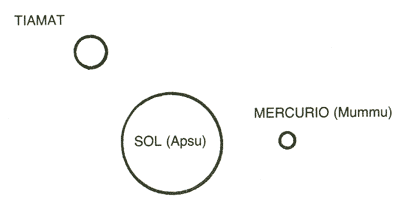
In the Beginning: Sol,
Mercury, "Tiamat"
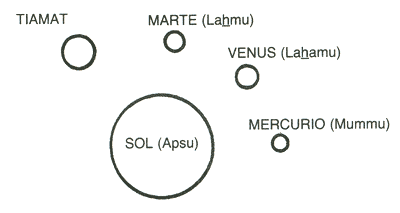
The interior planets -
the "gods in between" - born.
The process of the formation of the solar system then went on.
Lahmu
and Lahamu - Mars and Venus - were drought forth, but even
Before they had grown in age
And in stature to an appointed size -
God ANSHAR and god KISHAR were formed,
Surpassing them [in size].
As lengthened the days and multiplied the years,
God ANU became their son - of his ancestors a rival.
Then Anshar's first-born, Anu,
As his equal and in his image begot NUDIMMUD.
With a terseness matched only by the narrative's precision, Act I of
the epic of Creation has been swiftly played out before our very
eyes.
We are informed that Mars and Venus were to grow only to a
limited size; but even before their formation was complete, another
pair of planets was formed. The two were majestic planets, as
evidenced by their names - AN.SHAR ("prince, foremost of the
heavens") and KI.SHAR ("foremost of the firm lands"). They overtook
in size the first pair, "surpassing them" in stature.
The
description, epithets, and location of this second pair easily
identify them as Saturn and Jupiter.
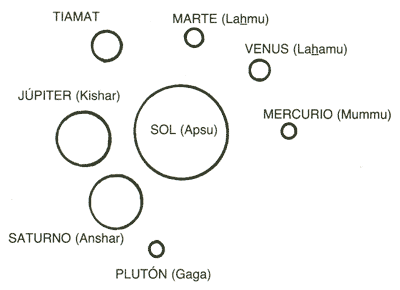
The SHAR - the giant
planets - are created, together with its "emissary".
Some time then passed ("multiplied the years"), and a third pair of
planets was brought forth.
First came ANU, smaller than Anshar and
Kishar ("their son"), but larger than the first planets ("of his
ancestors a rival" in size). Then Anu, in turn, begot a twin planet,
"his equal and in his image." The Babylonian version names the
planet NUDIMMUD, an epithet of Ea/Enki.
Once again, the descriptions
of the sizes and locations fit the next known pair of planets in our
solar system, Uranus and Neptune.
There was yet another planet to be accounted for among these outer
planets, the one we call Pluto. The "Epic of Creation" has already
referred to Anu as "Anshar's firstborn," implying that there was yet
another planetary god "born" to Anshar/Saturn.
The epic catches up
with this celestial deity later on, when it relates how Anshar sent
out his emissary GAGA on various missions to the other planets. Gaga
appears in function and stature equal to Apsu's emissary Mummu; this
brings to mind the many similarities between Mercury and Pluto.
Gaga, then, was Pluto; but the Sumerians placed Pluto on their
celestial map not beyond Neptune, but next to Saturn, whose
"emissary," or satellite, it was.
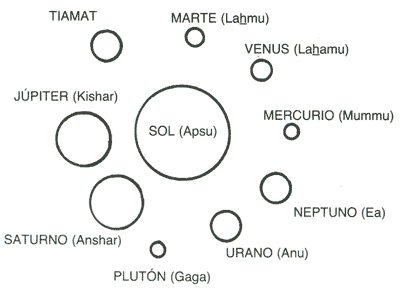
There are added the
last two planets - as their image.
As Act I of the "Epic of Creation" came to an end, there was a solar
system made up of the Sun and nine planets:
SUN - Apsu, "one who existed from the beginning."
MERCURY - Mummu, counselor and emissary of Apsu.
VENUS - Lahamu, "lady of battles."
MARS - Lahmu, "deity of war."
?? - Tiamat, "maiden who gave life."
JUPITER - Kishar, "foremost of firm lands."
SATURN - Anshar, "foremost of the heavens."
PLUTO - Gaga, counselor and emissary of Anshar.
URANUS - Anu, "he of the heavens."
NEPTUNE - Nudimmud (Ea), "artful creator."
Where were Earth and the Moon? They were yet to be created, products
of the forthcoming cosmic collision.
With the end of the majestic drama of the birth of the planets, the
authors of the Creation epic now raise the curtain on Act II, on a
drama of celestial turmoil. The newly created family of planets was
far from being stable.
The planets were gravitating toward each
other; they were converging on Tiamat, disturbing and endangering
the primordial bodies.
The divine brothers banded together;
They disturbed Tiamat as they surged back and forth.
They were troubling the "belly" of Tiamat
By their antics in the dwellings of heaven.
Apsu could not lessen their clamor;
Tiamat was speechless at their ways.
Their doings were loathsome. ...
Troublesome were their ways.
We have here obvious references to erratic orbits.
The new planets
"surged back and forth"; they got too close to each other ("banded
together"); they interfered with Tiamat's orbit; they got too close
to her "belly"; their "ways" were troublesome. Though it was Tiamat
that was principally endangered, Apsu, too, found the planets' ways
"loathsome."
He announced his intention to "destroy, wreck their
ways."
He huddled with Mummu, conferred with him in secret. But
"whatever they had plotted between them" was overheard by the gods,
and the plot to destroy them left them speechless. The only one who
did not lose his wits was Ea. He devised a ploy to "pour sleep upon
Apsu." When the other celestial gods liked the plan, Ka "drew a
faithful map of the universe" and cast a divine spell upon the
primeval waters of the solar system.
What was this "spell" or force exerted by "Ea" (the planet Neptune)
- then the outermost planet - as it orbited the Sun and circled all
the other planets? Did its own orbit around the Sun affect the Sun's
magnetism and thus its radioactive outpourings? Or did Neptune
itself emit, upon its creation, some vast radiations of energy?
Whatever the effects were, the epic likened them to a "pouring of
sleep" - a calming effect - upon Apsu (the Sun).
Even "Mummu, the
Counselor, was powerless to stir."
As in the biblical tale of Samson and Delilah, the hero - overcome
by sleep - could easily be robbed of his powers. Ea moved quickly to
rob Apsu of his creative role. Quenching, it seems, the immense
outpourings of primeval matter from the Sun, Ea/Neptune "pulled off
Apsu's tiara, removed his cloak of aura." Apsu was "vanquished."
Mummu could no longer roam about. He was "bound and left behind," a
lifeless planet by his master's side.
By depriving the Sun of its creativity - stopping the process of
emitting more energy and matter to form additional planets - the
gods brought temporary peace to the solar system. The victory was
further signified by changing the meaning and location of the Apsu.
This epithet was henceforth to be applied to the "Abode of Ea."
Any
additional planets could henceforth come only from the new Apsu -
from "the Deep" - the far reaches of space that the outermost planet
faced.
How long was it before the celestial peace was broken once more? The
epic does not say. But it does continue, with little pause, and
raises the curtain on Act III:
In the Chamber of Fates, the place of Destinies,
A god was engendered, most able and wisest of gods;
In the heart of the Deep was MARDUK created.
A new celestial "god" - a new planet - now joins the cast.
He was
formed in the Deep, far out in space, in a zone where orbital motion
- a planet's "destiny" - had been imparted to him. He was attracted
to the solar system by the outermost planet:
"He who begot him was
Ea" (Neptune).
The new planet was a sight to behold:
Alluring was his figure,
sparkling the lift of his eyes;
Lordly was
his gait,
commanding as of olden times... ,
Greatly exalted was he
above the gods, e
xceeding
throughout...
He was the loftiest of the gods,
surpassing was his height;
His
members were enormous,
he was exceedingly tall.
Appearing from outer space,
Marduk was still a newborn planet,
belching fire and emitting radiation.
"When he moved his lips, fire
blazed forth."
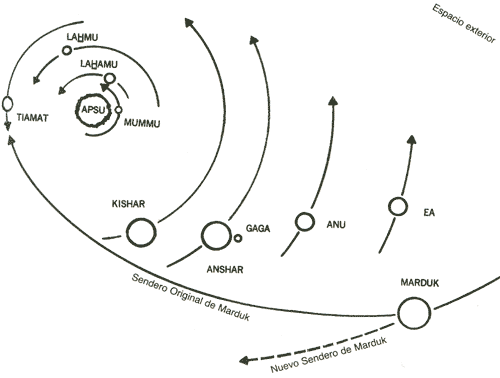
As Marduk neared the other planets,
"they heaped upon him their
awesome flashes," and he shone brightly, "clothed with the halo of
ten gods."
His approach thus stirred up electrical and other
emissions from the other members of the solar system. And a single
word here confirms our decipherment of the Creation epic: Ten
celestial bodies awaited him - the Sun and only nine other planets.
The epic's narrative now takes us along Marduk's speeding course. He
first passes by the planet that "begot" him, that pulled him into
the solar system, the planet Ea/ Neptune. As Marduk nears Neptune,
the latter's gravitational pull on the newcomer grows in intensity.
It rounds out Marduk's path,
"making it good for its purpose."
Marduk must still have been in a very plastic stage at that time.
As
he passed by Ea/Neptune, the gravitational pull caused the side of Marduk to bulge, as though he had "a second head."
No part of Marduk,
however, was torn off at this passage; but as Marduk reached the
vicinity of Anu/Uranus, chunks of matter began to tear away from
him, resulting in the formation of four satellites of Marduk.
"Anu
brought forth and fashioned the four sides, consigned I heir power
to the leader of the host."
Called "winds," the four were thrust
into a fast orbit around Marduk, "swirling as a whirlwind."
The order of passage - first by Neptune, then by Uranus - indicates
that Marduk was coming into the solar system not in the system's
orbital direction (counterclockwise) but from the opposite
direction, moving clockwise. Moving on, the oncoming planet was soon
seized by the immense gravitational and magnetic forces of the giant
Anshar/ Saturn, then Kishar/Jupiter.
His path was bent even more
inward - into the center of the solar system, toward Tiamat.
The approach of Marduk soon began to disturb Tiamat and the inner
planets (Mars, Venus, Mercury).
"He produced streams, disturbed Tiamat; the gods were not at rest, carried as in a storm."
Though the lines of the ancient text were partially damaged here, we
can still read that the nearing planet "diluted their vitals...
pinched their eyes." Tiamat herself "paced about distraught" - her
orbit, evidently, disturbed.
The gravitational pull of the large approaching planet soon began to
tear away parts of Tiamat. From her midst there emerged eleven
"monsters," a "growling, raging" throng of satellites who "separated
themselves" from her body and "marched at the side of Tiamat."
Preparing herself to face the onrushing Marduk, Tiamat "crowned them
with halos," giving them the appearance of "gods" (planets).
Of particular importance to the epic and to Mesopotamian cosmogony
was Tiamat's chief satellite, who was named KINGU,
"the first-born
among the gods who formed her assembly."
She exalted Kingu,
In their midst she made him great....
The high command of the battle
She entrusted into his hand.
Subjected to conflicting gravitational pulls, this large satellite
of Tiamat began to shift toward Marduk.
It was this granting to Kingu of a Tablet of Destinies - a planetary path of his own - that
especially upset the outer planets. Who had granted Tiamat the right
to bring forth new planets? Ea asked.
He took the problem to Anshar,
the giant Saturn.
All that Tiamat had plotted, to him he repeated:
"...she has set up an Assembly
and is furious with rage...
she has added matchless weapons, has borne
monster-gods...
withal eleven of this kind she has brought forth;
from among the gods who formed her Assembly,
she has elevated Kingu,
her first-born, made him chief...
she has given him a Tablet of Destinies, fastened it on his breast."
Turning to Ea, Anshar asked him whether he could go lo slay Kingu.
The reply is lost due to a break in the tablets; but apparently Ea
did not satisfy Anshar, for the continuing narrative has Anshar
turning to Anu (Uranus) lo find out whether he would "go and stand
up to Tiamat."
Hut Anu "was unable to face her and turned back."
In the agitated heavens, a confrontation builds; one god lifter
another steps aside. Will no one do battle with the raging Tiamat?
Marduk, having passed Neptune and Uranus, is now nearing Anshar
(Saturn) and his extended rings.
This gives Anshar an idea:
"He who
is potent shall be our Avenger; ho who is keen in battle: Marduk,
the Hero!"
Coming within reach of Saturn's rings ("he kissed the
lips of Anshar"), Marduk answers:
"If I, indeed, as your Avenger
Am to vanquish Tiamat, save your lives -
Convene an Assembly to proclaim my Destiny supreme!"
The condition was audacious but simple: Marduk and his "destiny" -
his orbit around the Sun - were to be supreme among all the
celestial gods.
It was then that Gaga, Anshar/Saturn's satellite -
and the future Pluto - was loosened from his course:
Anshar opened his mouth,
To Gaga, his Counsellor,
a word he addressed....
"Be on thy way, Gaga,
take the stand before the gods,
and that which I shall tell thee
repeat thou unto them."
Passing by the other god/planets, Gaga urged them to ! "fix your
decrees for Marduk."
The decision was as anticipated: The gods were
only too eager to have someone else go to settle the score for them.
"Marduk is king!" they shouted, and urged him to lose no more time.
"Go and cut off the life of Tiamat!"
The curtain now rises on Act IV, the celestial battle.
The gods have decreed Marduk's "destiny"; their combined
gravitational pull has now determined Marduk's orbital path so that
he can go but one way - toward a "battle," a collision with Tiamat.
As befits a warrior, Marduk armed himself with a variety j of
weapons. He filled his body with a "blazing flame";
"he constructed
a bow... attached thereto an arrow... in front of him he set the
lightning"
"he then made a net to enfold Tiamat therein."
These
are common names for what could only have been celestial phenomena -
the discharge of electrical bolts as the two planets converged, the
gravitational pull (a "net") of one upon the other.
But Marduk's chief weapons were his satellites, the four "winds"
with which Uranus had provided him when Marduk passed by that
planet: South Wind, North Wind, East Wind, West Wind. Passing now by
the giants, Saturn and Jupiter, and subjected to their tremendous
gravitational pull, Marduk "brought forth" three more satellites -
Evil Wind, Whirlwind, and Matchless Wind.
Using his satellites as a,
"storm chariot," he "sent forth the winds
that he had brought forth, the seven of them."
The adversaries were
ready for battle.
The Lord went forth, followed his course;
Towards the raging Tiamat
he set his face....
The Lord approached to scan the innerside of Tiamat -
The scheme of Kingu, her consort, to perceive.
But as the planets drew nearer each other, Marduk's course became
erratic:
As he looks on, his course becomes upset,
His direction is distracted, his doings are confused.
Even Marduk's satellites began to veer off course:
When the gods, his helpers,
Who were marching at his side,
Saw the valiant Kingu, blurred became their vision.
Were the combatants to miss each other after all?
But the die was cast, the courses irrevocably set on collision.
"Tiamat
emitted a roar"... "the Lord raised the flooding storm, his
mighty weapon."
As Marduk came ever closer, Tiamat's "fury" grew;
"the roots of her legs shook back and forth." She commenced to cast
"spells" against Marduk - the same kind of celestial waves Ea had
earlier used against Apsu and Mummu.
But Marduk kept coming at her.
Tiamat and Marduk, the wisest of the gods,
Advanced against one another;
They pressed on to single combat,
They approached for battle.
The epic now turns to the description of the celestial battle,
in
the aftermath of which Heaven and Earth were
created.
The Lord spread out his net to enfold her;
The Evil Wind, the rearmost, he unleashed at her face.
As she opened her mouth, Tiamat, to devour him -
He drove in the Evil Wind so that she close not her lips.
The fierce storm Winds then charged her belly;
Her body became distended; her mouth had opened wide.
He shot there through an arrow, it tore her belly;
It cut through her insides, tore into her womb.
Having thus subdued her, her life-breath he extinguished.
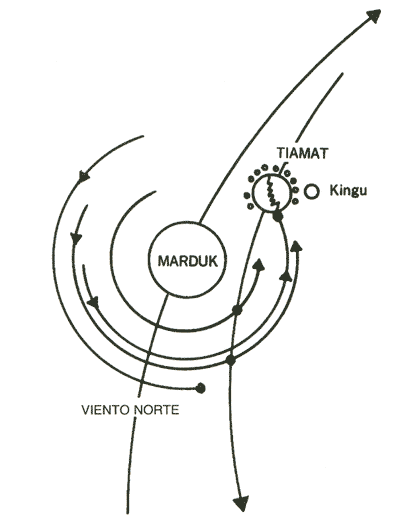
Here, then, is a most original theory explaining the celestial
puzzles still confronting us.
An unstable solar system, made up of
the Sun and nine planets, was invaded by a large, comet-like planet
from outer space. It first encountered Neptune; as it passed by
Uranus, the giant Saturn, and Jupiter, its course was profoundly
bent inward toward the solar system's center, and it brought forth
seven satellites.
It was unalterably set on a collision course with Tiamat, the next planet in line. A. Marduk's "winds" colliding with
Tiamat and her "host" (led by Kingu).
But the two planets did not collide, a fact of cardinal astronomical
importance: It was the satellites of Marduk I hat smashed into
Tiamat, and not Marduk himself. They "distended" Tiamat's body, made
in her a wide cleavage. Through these fissures in Tiamat, Marduk
shot an "arrow," a "divine lightning," an immense bolt of
electricity that lumped as a spark from the energy-charged Marduk,
the planet that was "filled with brilliance."
Finding its way into Tiamat's innards, it "extinguished her life-breath" - neutralized
Tiamat's own electric and magnetic forces and Holds, and
"extinguished" them.
The first encounter between Marduk and Tiamat left IKT fissured and
lifeless; but her final fate was still to be determined by future
encounters between' the two. Kingu, louder of Tiamat's satellites,
was also to be dealt with separately.
But the fate of the other ten,
smaller satellites of Tiamat was determined at once.
After he had slain Tiamat, the leader, Her band was shattered, her
host broken up. The gods, her helpers who marched at her side,
Trembling with fear, Turned their backs about so as to save and
preserve their lives.
Can we identify this "shattered... broken" host that trembled and
"turned their backs about" - reversed their direction?
By doing so we offer an explanation to yet another )ii7./le of our
solar system - the phenomenon of the comets. Tiny globes of matter,
they are often referred to as the solar system's "rebellious
members," for they appear to obey none of the normal rules of the
road. The orbits of the planets around the Sun are (with the
exception of Pluto) almost circular; the orbits of the comets are
elongated, and in most instances very much so - to the extent that
some of them disappear from our view for hundreds or thousands of
years.
The planets (with the exception of Pluto) orbit the Sun in
the same general plane; the comets' orbits lie in many diverse
planes. Most significant, while all the planets known to us circle
the Sun in the same counterclockwise direction, many comets move in
the reverse direction.
Astronomers are unable to say what force, what event created the
comets and threw them into their unusual orbits. Our answer: Marduk.
Sweeping in the reverse direction, in an orbital plane of his own,
he shattered, broke the host of Tiamat into smaller comets and
affected them by his gravitational pull, his so-called net:
Thrown into the net,
they found themselves ensnared....
The whole
band of demons that
had marched on her side
He cast into fetters,
their hands he bound....
Tightly encircled,
they could not
escape.
After the battle was over, Marduk took away from Kingu the Tablet of
Destinies (Kingu's independent orbit) and attached it to his own (Marduk's)
breast: his course was bent into permanent solar orbit. From that
time on, Marduk was bound always to return to the scene of the
celestial battle.
Having "vanquished" Tiamat, Marduk sailed on in the heavens, out
into space, around the Sun, and back to retrace his passage by the
outer planets: Ea/Neptune, "whose desire Marduk achieved," Anshar/Saturn,
"whose triumph Marduk established."
Then his new orbital path
returned Marduk to the scene of his triumph, "to strengthen his hold
on the vanquished gods," Tiamat and Kingu.
As the curtain is about to rise on Act V, it will be here - and only
here, though this has not hitherto been realized - that the biblical
tale of Genesis joins the Mesopotamian "Epic of Creation"; for it is
only at this point that the tale of the Creation of Earth and Heaven
really began.
Completing his first-ever orbit around the Sun, Marduk "then
returned to Tiamat, whom he had subdued."
The Lord paused to view her lifeless body.
To divide the monster he then artfully planned.
Then, as a mussel, he split her into two parts.
Marduk himself now hit the defeated planet, splitting Tiamat in two,
severing her "skull," or upper part.
Then another of Marduk's
satellites, the one called North Wind, crashed into the separated
half. The heavy blow carried this part - destined to become Earth -
to an orbit where no planet had been orbiting before:
The Lord trod upon Tiamat's hinder part;
With his weapon the
connected skull he cut loose;
He severed the channels of her blood;
And caused the North Wind to bear it
To places that have been
unknown.
Earth had been created!
The lower part had another fate: on the second orbit, Marduk himself
hit it, smashing it to pieces:
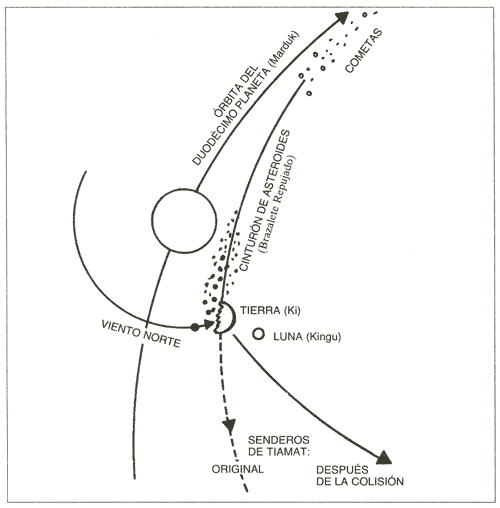
The [other] half of her he set up as a screen for the skies:
Locking
them together, as watchmen he stationed them. . .
He bent Tiamat's
tail to form the Great Band as a bracelet.
The pieces of this broken half were hammered to become a "bracelet"
in the heavens, acting as a screen between the inner planets and the
outer planets. They were stretched out into a "great band." The
asteroid belt had been created.
Astronomers and physicists recognize the existence of great
differences between the inner, or "terrestrial," planets (Mercury,
Venus, Earth and its Moon, and Mars) and the outer planets (Jupiter
and beyond), two groups separated by the asteroid belt. We now find,
in the Sumerian epic, ancient recognition of these phenomena.
Moreover, we are offered - for the first time - a coherent
cosmogonic-scientific explanation of the celestial events that led
to the disappearance of the "missing planet" and the resultant
creation of the asteroid belt (plus the comets) and of Earth.
After
several of his satellites and his electric bolts split Tiamat in
two, another satellite of Marduk shunted her upper half to a new
orbit as our planet Earth; then Marduk, on his second orbit, smashed
the lower half to pieces and stretched them in a great celestial
band.
Every puzzle that we have mentioned is answered by the "Epic of
Creation" as we have deciphered it. Moreover, we also have the
answer to the question of why Earth's continents are concentrated on
one side of it and a deep
cavity (the Pacific Ocean's bed) exists on the opposite side. The
constant reference to the "waters" of Tiamat is also illuminating.
She was called the Watery Monster, and it stands to reason that
Earth, as part of Tiamat, was equally endowed with these waters.
Indeed, some modern scholars describe Earth as "Planet Ocean" - for
it is the only one of the solar system's known planets that is
blessed with such life-giving waters.
New as these cosmologic theories may sound, they were accepted fact
to the prophets and sages whose words fill the Old Testament. The
prophet Isaiah recalled "the primeval days" when the might of the
Lord "carved the Haughty One, made spin the watery monster, dried up
the waters of Tehom-Raba." Calling the Lord Yahweh "my primeval
king," the Psalmist rendered in a few verses the cosmogony of the
epic of Creation. "By thy might, the waters thou didst disperse; the
leader of the watery monsters thou didst break up."
Job recalled how
this celestial Lord also smote "the assistants of the Haughty One";
and with impressive astronomical sophistication exalted the Lord
who:
The hammered canopy stretched out in the place of Tehom,
The Earth suspended in the void. ...
His powers the waters did arrest,
His energy the Haughty One did cleave;
His Wind the Hammered Bracelet measured out;
His hand the twisting dragon did extinguish.
Biblical scholars now recognize that the Hebrew Tehom ("watery
deep") stems from Tiamat; that Tehom-Raba means "great Tiamat," and
that the biblical understanding of primeval events is based upon the
Sumerian cosmologic epics.
It should also be clear that first and
foremost among these parallels are the opening verses of the Book of
Genesis, describing how the Wind of the Lord hovered over the waters
of Tehom, and how the lightning of the Lord (Marduk in the
Babylonian version) lit the darkness of space as it hit and split
Tiamat, creating Earth and the Rakia (literally, "the hammered
bracelet").
This celestial band (hitherto translated as "firmament")
is called "the Heaven."
The Book of Genesis (1:8) explicitly states that it is this
"hammered out bracelet" that the Lord had named "heaven" (shamaim).
The Akkadian texts also called this celestial zone "the hammered
bracelet" (rakkis), and describe how Marduk stretched out Tiamat's
lower part until he brought it end to end, fastened into a permanent
great circle. The Sumerian sources leave no doubt that the specific
"heaven," as distinct from the general concept of heavens and space,
was the asteroid belt.
Our Earth and the asteroid belt are the "Heaven and Earth" of both
Mesopotamian and biblical references, created when Tiamat was
dismembered by the celestial Lord.
After Marduk's North Wind had pushed Earth to its new celestial
location, Earth obtained its own orbit around the Sun (resulting in
our seasons) and received its axial spin (giving us day and night).
The Mesopotamian texts claim that one of Marduk's tasks after he
created Earth was, indeed, to have "allotted [to Earth] the days of
the Sun and established the precincts of day and night."
The
biblical concepts are identical:
And God said:
"Let there be Lights in the hammered Heaven,
to divide between the Day and the Night;
and let them be celestial signs
and for Seasons and for Days and for Years."
Modem scholars believe that after Earth became a planet it was a hot
ball of belching volcanoes, filling the skies with mists and clouds.
As temperatures began to cool, the vapors turned to water,
separating the face of Earth into dry land and oceans.
The fifth tablet of Enuma Elish, though badly mutilated, imparts
exactly the same scientific information. Describing the gushing lava
as Tiamat's "spittle," the Creation epic correctly places this
phenomenon before the formation of the atmosphere, the oceans of
Earth, and the continents.
After the "cloud waters were gathered,"
the oceans began to form, and the "foundations" of Earth - its
continents - were raised. As "the making of cold" - a cooling off -
took place, rain and mist appeared. Meanwhile, the "spittle"
continued to pour forth, "laying in layers," shaping Earth's
topography.
Once again, the biblical parallel is clear:
And God said:
"Let the waters under the skies be gathered together,
unto one place, and let dry land appear."
And it was so.
Earth, with oceans, continents, and an atmosphere, was now ready for
the formation of mountains, rivers, springs, valleys.
Attributing
all Creation to the Lord Marduk,
Enuma Elish continued the
narration:
Putting Tiamat's head [Earth] into position,
He raised the mountains thereon.
He opened springs, the torrents to draw off.
Through her eyes he released the Tigris and Euphrates.
From her teats he formed the lofty mountains,
Drilled springs for wells, the water to carry off.
In perfect accord with modern findings, both the Book of Genesis and
Enuma Elish and other related Mesopotamian texts place the beginning
of life upon Earth in the waters, followed by the "living creatures
that swarm" and "fowl that fly."
Not until then did "living
creatures after their kind: cattle and creeping things and beasts"
appear upon Earth, culminating with the appearance of Man – the
final act of Creation.
As part of the new celestial order upon Earth, Marduk,
"made the
divine Moon appear... designated him to mark the night, define
the days every month."
Who was this celestial god?
The text calls him SHESH.KI ("celestial
god who protects Earth"). There is no mention earlier in the epic of
a planet by this name; yet there he is, "within her heavenly
pressure [gravitational field]." And who is meant by "her": Tiamat
or Earth?
The roles of, and references to, Tiamat and Earth appear to be
interchangeable. Earth is Tiamat reincarnated. The Moon is called
Earth's "protector"; that is exactly what Tiamat called Kingu, her
chief satellite.
The Creation epic specifically excludes Kingu from the "host" of
Tiamat that were shattered and scattered and put into reverse motion
around the Sun as comets.
After Marduk completed his own first orbit
and returned to the scene of the battle, he decreed Kingu's separate
fate:
And Kingu, who had become chief among them,
He made shrink;
As god DUG.GA.E he counted him.
He took from him the Tablet of Destinies,
Not rightfully his.
Marduk, then, did not destroy Kingu.
He punished him by taking away
his independent orbit, which Tiamat had granted him as he grew in
size. Shrunk to a smaller size, Kingu remained a "god" - a planetary
member of our solar system. Without an orbit he could only become a
satellite again. As Tiamat's upper part was thrown into a new orbit
(as the new planet Earth), we suggest, Kingu was pulled along. Our
Moon, we suggest, is Kingu, Tiamat's former satellite.
Transformed into a celestial duggae, Kingu had been stripped of his
"vital" elements - atmosphere, waters, radioactive matter; he shrank
in size and became "a mass of lifeless clay." These Sumerian terms
fittingly describe our lifeless Moon, its recently discovered
history, and the fate that befell this satellite that started out as
KIN.GU ("great emissary") and ended up as DUG.GA.E ("pot of lead").
L. W. King (The Seven Tablets of Creation) reported the existence of
three fragments of an astronomical-mythological tablet that
presented another version of Marduk's battle with Tiamat, which
included verses that dealt with the manner in which Marduk
dispatched Kingu.
"Kingu, her spouse, with a weapon not of war he
cut away... the Tablets of Destiny from Kingu he took in his
hand."
A further attempt, by B. Landesberger (in 1923, in the Archiv
fur Keilschriftforschung), to edit and fully translate the text,
demonstrated the interchangeability of the names Kingu/Ensu/Moon.
Such texts not only confirm our conclusion that Tiamat's main
satellite became our Moon; they also explain NASA's findings
regarding a huge collision "when celestial bodies the size of large
cities came crashing into the Moon."
Both the NASA findings and the
text discovered by L. W. King describe the Moon as the "planet that
was laid waste."
Cylinder seals have been found that depict the celestial battle,
showing Marduk fighting a fierce female deity.
One such depiction
shows Marduk shooting his lightning at Tiamat, with Kingu, clearly
identified as the Moon, trying to protect Tiamat, his creator.
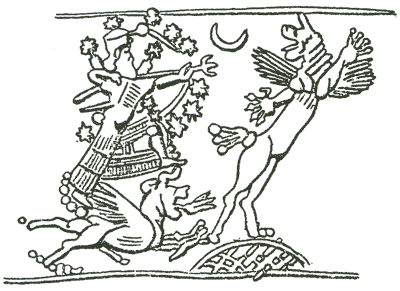
This pictorial evidence that Earth's Moon and Kingu were the same
satellite is further enhanced by the etymological fact that the name
of the god SIN, in later times associated with the Moon, derived
from SU.EN ("lord of wasteland").
Having disposed of Tiamat and Kingu, Marduk once again "crossed the
heavens and surveyed the regions." This time his attention was
focused on "the dwelling of Nudimmud" (Neptune), to fix a final
"destiny" for Gaga, the erstwhile satellite of Anshar/Saturn who was
made an "emissary" to the other planets.
The epic informs us that as one of his final acts in the heavens,
Marduk assigned this celestial god" "to a hidden place," a hitherto
unknown orbit facing "the deep" (outer space), and entrusted to him
the "counsellorship of the Watery Deep." In line with his new
position, the planet was renamed US.MI ("one who shows the way"),
the outermost planet, our Pluto.
According to the Creation epic, Marduk had at one point boasted,
"The ways of the celestial gods I will artfully alter... into two
groups shall they be divided."
Indeed he did.
He eliminated from the heavens the Sun's first
partner-in-Creation, Tiamat. He brought Earth into being, thrusting
it into a new orbit nearer the Sun. He hammered a "bracelet" in the
heavens - the asteroid belt that does separate the group of inner
planets from the group of outer planets.
He turned most of Tiamat's
satellites into comets; her chief satellite, Kingu, he put into
orbit around Earth to become the Moon. And he shifted a satellite of
Saturn, Gaga, to become the planet Pluto, imparting to it some of
Marduk's own orbital characteristics (such as a different orbital
plane).
The puzzles of our solar system - the oceanic cavities upon Earth,
the devastation upon the Moon, the reverse orbits of the comets, the
enigmatic phenomena of Pluto - • all are perfectly answered by the
Mesopotamia!! Creation epic, as deciphered by us.
Having thus "constructed the stations" for the planets, Marduk took
for himself "Station
Nibiru," and "crossed the heavens and surveyed"
the new solar system. It was now made up of twelve celestial bodies,
with twelve Great Gods as their counterparts.
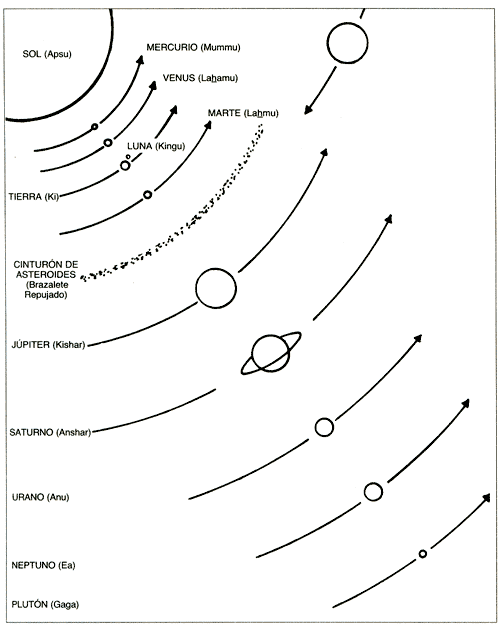
Return to Contents
|











